Ripped jeans are one of the most controversial items in a fashionable wardrobe. Holey pants delight some, while for others they cause only bewilderment and irritation. However, both supporters and opponents of ripped jeans will agree that today it is one of the main trends in clothing.

Ripped jeans have not gone out of fashion for several seasons in a row, so more and more girls and young people are thinking about buying such a thing. But the prices for such pants are not lower, and sometimes even higher than for whole clothes, and not everyone is ready to overpay for an impractical, though fashionable thing.
The solution to this problem is obvious - to make fashionable holey jeans with your own hands. For detailed instructions on how to do this at home, read below.




Is it possible to make ripped jeans out of ordinary jeans?
It is most correct to make fashionable ripped trousers from old, but beloved jeans that have already managed to fray, but it is a pity to throw them away. Such jeans usually have scuffs and holes in the right places - we can only enhance the effect a little.
You should not give a second life to pants that are already quite worn out and are in a “dumping” condition, because our task is to look stylish, but neat. Therefore, jeans with indelible spots, holes between the legs and other defects that cannot be fixed, it is better to throw it away.



If you don’t have the right old jeans at your disposal, you can try modifying the new pants.Buying good, expensive jeans for these purposes is not recommended, because the result may disappoint you.
For the first experience, we advise you to buy inexpensive jeans for sale at a discount center. The main thing is that they are of acceptable quality and fit well.
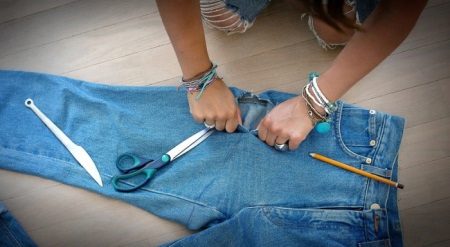
Where do they make holes?
To make a truly stylish thing and look perfect in it, it is important to know the right places where you need to make holes.
Usually holes are made on the following parts of jeans:
- pockets - back and front;
- belt - in this place it is better to do neat terry and scuffs, rather than through holes;
- trousers - the most comfortable and most popular place; holes can be made everywhere except for the knee area: in this area, the fabric stretches very much and the holes quickly increase in size, so the holes should be located a few centimeters above or below the knees.








What materials are needed?
You can get beautiful fringed holes only by using a special set of tools and materials.
If you simply cut the jeans with scissors or a razor, the effect will be completely different from what you would expect.


Therefore, to work you need to stock up:
- a small piece of plywood or thick cardboard;
- a sharp knife, for example, clerical;
- wax crayon or remnant;
- sewing steamer;
- fine grater, file or piece of sandpaper;
- A set of safety pins, tweezers and a vacuum cleaner may also be needed.
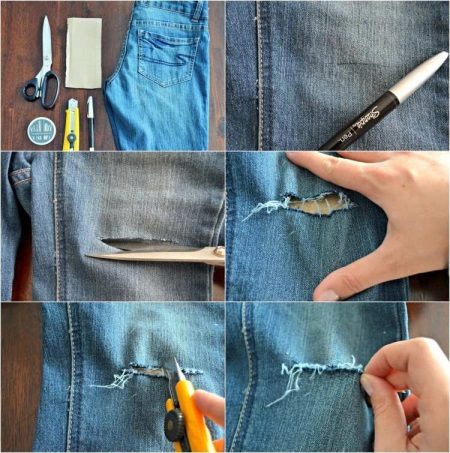
How to make holes: step by step instructions
- First, decide on the future appearance of jeans. For convenience, you can even draw a sketch on which the location of all the decor elements will be marked: holes, scuffs, patches, etc.
- After that, transfer the sketch directly to the jeans. Mark directly on the front of your pants with a piece of soap or crayon. If you have a washable marker, it will be more convenient to use it.
- Now you need to examine the denim. Take a good look at weaving and locate the white and colored threads. It is important for you to understand which of them are going vertically and which are horizontally. If it is difficult to determine this by eye, make an incision in an inconspicuous place and disassemble the edge along the threads.
- Before starting work, place something solid, for example, a piece of plywood, under the site of the future cut, so as not to damage the other side of the jeans. Plywood needs to be stuck in the trouser leg, and not just put pants on it!
- Start cutting according to the marked markup. Do not make the cuts too long, as they will still gradually sprawl. To make the holes “like in a store”, try to make an incision in one motion.
- Now you need to give fresh tears a stylish shabby look. For this we need a sewing spreader. With its help, carefully pull out the white threads, and remove colored ones. If you don’t like the holes covered with threads, you can just walk along the edges with a grater or nail file.
- Quickly remove thread trimming and dust remaining after working with a file, you can use a special sticky roller for clothes or a hand vacuum cleaner.
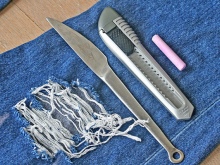
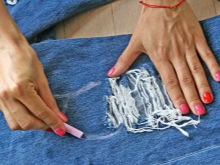
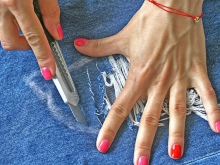
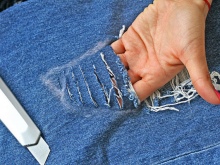
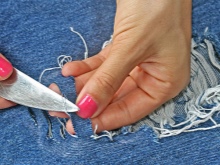

Add the scuff effect
You can make the model even more interesting by adding a worn effect to jeans.

To do this, you can use any improvised means with an abrasive effect:
- kitchen graters;
- nail files;
- sand paper;
- whetstones for sharpening knives.
Just grab one of these tools and start carefully crafting your jeans in the right place. Be careful: do not damage the white threads, otherwise the abrasions will quickly turn into holes.
To make the scuffs brighter and look more expressive, go over them with a sponge dampened in a bleaching agent (remember that you need to work with rubber gloves, since bleach is dangerous for the skin).
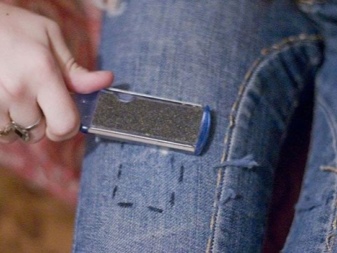
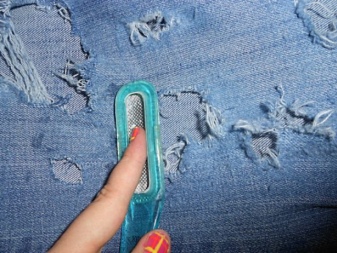
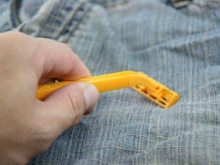
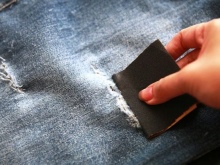
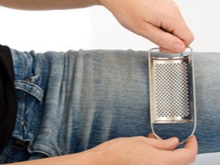
Decor and lace decoration
Those who simply ripped jeans seem not spectacular enough can be advised to additionally decorate them with lace inserts.The combination of rough denim and delicate lace looks very beautiful and unusual.

For decor, we need very little lace, so if you still have trimmed lace ribbons, this is just fine. Light jeans are best decorated with black lace accents, and dark ones with white.
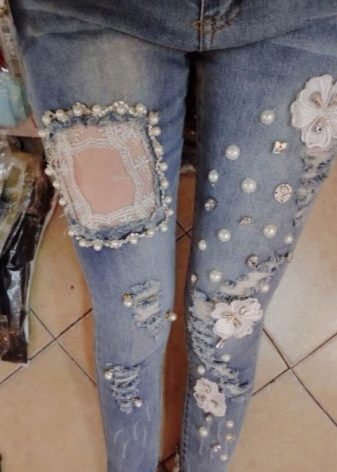

Sew on lace from the wrong side. The patch should be slightly larger than the hole itself. Do not be afraid to cut too large a fragment - after finishing work, excess can be easily cut.
Lace should be sewn along the contour of the hole with small, frequent stitches (for convenience, the patch can be fixed with English pins). Choose threads to match the lace - so they will be less noticeable.













